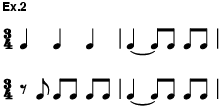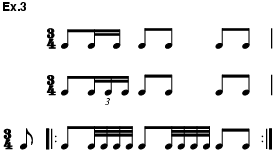
A Spanish popular dance or song. Its dancers are called boleros or boleras. Of the several possible etymologies considered by Suárez-Pajares (A1993), the most plausible are those deriving from the verb volar (‘to fly’) and from the name boleras, given to the Gypsy women ‘who were the first to dance it [and called so] because of the little gold-braided balls (bolitas de pasamanería) that adorned their dresses’. From its beginnings in Spain during the last third of the 18th century the bolero's popularity in the court and theatre persisted throughout the 19th century, and it has since been absorbed among the traditional dance and song genres of Andalusia, Castile and Mallorca.
Consensus among the early writers (Sor, A1835; El Solitario, A1847) points to the bolero’s having derived from the seguidilla, whose accompanying rhythm and movements it modified and to whose verse form it was sung. After the seguidilla had absorbed steps and movements from such other dances as the fandango, polo, tirana and cachucha, two types gained prominence: the seguidilla manchega (which later became the bolero) and the seguidilla murciana. The former was much quicker and began with two verses, whereas the latter began with one. Comparison of a typical bolero and seguidilla manchega (ex.1) reveals their similarity.

The bolero is in moderate tempo and triple metre. It is usually performed by a couple, but in theatrical performances was executed by four to eight couples. It comprises three equal sections (coplas), each beginning with a paseo (promenade). Only in the middle section is solo performance alternated with couple-dancing. The bien parado (a fixed pose with one arm arched over the head and the other crossed in front of the chest) closes each section and, sometimes, phrases within the section. Complicated steps, including the cuarta (kicking and crossing the feet while executing a leap) and battement (in which the lifted leg is struck against the standing leg), and fast movements characterize the solo sections. The dancers accompany themselves with singing (often a vocalise) and castanets, and sometimes also on the guitar and tambourine. Musically the Spanish bolero is usually in AAB form. The entry of the voice is preceded by at least one bar of sharply marked rhythm, and short instrumental interludes separate the sung couplets. The earliest rhythms (shown in ex.2) took on characteristics closely related to traditional polonaise rhythm (ex.3).


Varying interpretations of the dance are found in Mexico, Cuba and other Latin American countries, especially Colombia and Venezuela. The Cuban bolero is a duple-metre dance that exhibits closer relationships with the habanera and Afro-Cuban musical styles than with its Spanish counterpart. It is a binary song form that developed from such 19th-century forms as the conga, danzón and contradanza. Its often sentimental quatrains, sometimes as many as 20, are presented in two contrasting musical periods characterized by long, flowing melodies. Rhythm is characteristically complex and includes the use of the cinquillo (ex.4) and tresillo (ex.5) in the melody as well as in the accompaniment, which is for bongo, conga drum and claves.
![]()
![]()
According to Suárez-Pajares (A1993), the earliest use of the term ‘bolero’ was the dance Ramón de la Cruz specified for his sainete La hostería del buen gusto (1773). Dances were often incorporated in sainetes and in entremeses inserted between the acts of longer plays and lyrical dramas. Boleros were also included in many 18th- and 19th-century tonadillas and zarzuelas. J.A. Zamácola (1756–1826), a prominent Spanish folklorist and song collector who wrote under the pseudonym Don Preciso, attributed the dance's origin to Sebastián (Lorenzo) Cerezo or Zerezo, an acclaimed dancer from La Mancha. J.J. Rodríguez Calderón, writing in 1807, credited the Gypsy-born dancer Antón Boliche from Seville (d 1794) with having refined its movements and surmised that his surname possibly have earned him the nickname Bolero.
Among the foreign authors who kept journals of their travels in Spain during the late 18th and early 19th centuries, the Englishman J. Townsend described the dance (volero) performed at a ball in Aranjuez, seeing in it some resemblance to the fandango. The German C.A. Fischer saw it performed in a theatre in Cádiz and described it in more detail, mentioning printed material available from bookstalls in the Puerta del Sol district in Madrid. These manuals and methods, bearing such titles as L'animas que manifiestan los varias pasos, y mudanzas de los seguidillas voleros y los trages mas proprios para esse bayle and Modo facil para aprender el ayre volero en la guitarra y arreglar la voz, may be the earliest sources of their kind. The poet Théophile Gautier described in contemptuous terms a performance he and a companion witnessed in a theatre in Vitoria, their first viewing of a national Spanish dance (baile nacional).
Around the beginning of the 19th century the Spanish dancer Requejo initiated reforms in bolero dancing in a successful collaboration with the Spanish violinist and composer Dámaso Cañada (d 1849), whose boleros teatrales were written as instrumental dances with the flute replacing the voice. (The Dance de Reguejo, arranged for flute and piano and possibly from Cañada's collection, is printed in Sor, A1835, p.91, and several boleros by Cañada can be found in Paz, B1813.) In Seville, which was not affected by Requejo's reforms, a theatrical form of the bolero took root, giving rise to the so-called bolero school (see Cairón, B1820). Curiously, the term ‘bolero’ was not included in the Diccionario de la lengua castellana, issued by the Real Academia Española, until the fifth edition (1817), where it was defined as requiring ‘much grace and elegance’ (mucho garbo y gentileza), clearly a reference to the elevated taste of the bolero school.
The bolero quickly found favour beyond Spain's borders. It was extremely popular in Paris, and was included in the repertory of the singer-composer Manuel García in his tours throughout Europe, the USA and Mexico. Along with the older fandango, seguidilla and tirana, the bolero became one of the most popular dances in the New World during the colonial period. The Cuban bolero, however, superseded the Spanish one in Latin America, entering the repertory of marimba bands in Central America and Mexico during the 19th century. Two types of bolero exist in Mexico: the romantico, danced and/or sung, which has an international music-hall character, and the ranchero, only sung, which is found only in Mexico and is accompanied by a mariachi consort using stylized bolero rhythms. In Colombia and Venezuela boleros are part of the popular song repertory.
Early examples of the bolero in art music are Sor's famous bolero for three female voices (ed. in Mitjana y Gordón, A1920, p.2335), dating from around the middle of the period of the dance's greatest popularity in Spain, and two of Beethoven's folksong arrangements with piano, violin and cello accompaniment: the ‘bolero a solo’ Una paloma blanca and ‘bolero a due’ Como la mariposa woo158a nos.19–20. Opera composers were also attracted to the form: Weber included a bolero in the incidental music to Preciosa (1820), and in Der Freischütz (1821) he employed its rhythm in the arietta ‘Kommt ein schlanker Bursch gegangen’; further examples are found in the works of Méhul (Les deux aveugles de Tolède, 1806), Auber (La muette de Portici, 1828; Le domino noir, 1837), Berlioz (Benvenuto Cellini, 1838), Joaquín Gaztambide (the zarzuela El estreno de un artista, 1852) and Verdi (Les vêpres siciliennes, 1855). Moritz Moszkowski composed boleros for violin and piano (op.16 no.2) and for piano solo (op.12 no.5). Chopin's Boléro op.19 more nearly resembles a polonaise, particularly in the allegro vivace. Ravel's Boléro (1928), initially conceived under the title Fandango, employs a consistently moderate and uniform tempo, as much in its melody and harmony as in its recurrent underlying rhythm, which suggests a fleeting relationship with the traditional dance (ex.6).

Grove6 (‘Seguidilla’; J. Sage)
LaborD
MGG1 (W. Kahl)
J. Townsend: Journey Through Spain in the Years 1761–1787 (Dublin 1792)
C.A. Fischer: Reise von Amsterdam über Madrid und Cadiz nach Genua in den Jahren 1797 und 1798 (Berlin, 1799)
F. Sor: ‘Le bolero’, Encyclopédie pittoresque de la musique, ed. A. Ledhuy and H. Bertini (Paris, 1835)
T. Gautier: Voyage en Espagne/Tra los montes (Paris, 1843; Eng. trans., 1853, as Wanderings in Spain)
El Solitario [S. Estébanez Calderón]: Escenas andaluzas (Madrid, 1847); ed. A. González Troyano (Madrid, 1985)
F.A. Barbieri: Las castañuelas: estudio jocoso dedicados a todos los boleros y danzantes, por uno de tantos (Madrid, 1878/R)
F. Pedrell: Diccionario técnico de la música (Barcelona, 1894)
R. Mitjana y Gordón: ‘La musique en Espagne’, EMDC, I/iv (1920), 1913–2350
E. Cotarelo y Mori: Historia de la zarzuela, ó sea El drama lírico en España (Madrid, 1934)
M.N. Hamilton: Music in Eighteenth Century Spain (Urbana, IL, 1937/R)
G. Chase: The Music of Spain (New York, 1941, 2/1959)
J. Subirá: Historia de la música teatral en España (Barcelona, 1945)
L. Tozzi: Bolero: storia de un'ossessione (Rome, 1981)
R. Paz: ‘La escuela bolera’, Ritmo, no.564 (Madrid, 1986), 52
M.E. Cortizo: ‘El bolero español del siglo XIX: estudio formal’, IMSCR XV: Madrid 1992 [RdMc, xvi, 1993], 2017–26
H. Restrepo Duque: Lo que cuentan los boleros (Santafé de Bogotá, Colombia, 1992)
E.D. Albanedo: ‘Iconography of the Bolero’, Studies in Dance History, ed. J. Suárez-Pajares and X.M. Carreira, iv/1 (1993), 39–59
N.L. Chalfa Ruyter: ‘La escuela bolera’, Dance Chronicle, xvi/2 (1993), 249–57
J. Suárez-Pajares: ‘Historical Overview of the Bolero from its Beginnings to the Genesis of the Bolero School’, Studies in Dance History, ed. J. Suárez-Pajares and X.M. Carreira, iv/1 (1993), 1–19
J. Rico Salazar: Cien años de boleros (Bogotá, 4/1994)
F.A. Florencio [J. Fernández de Rojas]: Crotalogía, o Ciencia de las castañuelas: instrucción científica del modo de tocar las castañuelas para baylar el bolero, y poder fácilmente, y sin necesidad de maestro, acompañarse en todos las mudanzas, de que está adornado este gracioso bayle español (Madrid, 1792) [according to Súarez-Pajares, not be taken seriously]
Don Preciso [J.A.I. Zamácola]: Colección de las mejores coplas de seguidillas, tiranas y polos que se han compuesto para cantar a la guitarra (Madrid, 1799, enlarged 3/1805, 1982/R)
J.J. Rodríguez Calderón: La bolerología, o Quadro de las escuelas del baile bolero, tales cuales eran en 1794 y 1795 en la corte de España (Philadelphia, 1807)
N. Paz: Collection des meilleurs airs nationaux espagnols: boleras et tiranas (Paris, 1813)
A. Cairón: Compendio de las principales reglas del baile traducido del francés por … y aumentado de una explicación exacta y método de ejecutar la mayor parte de los bailes conocidos en España, tanto antiguos como modernos (Madrid, 1820)
S. de Masarnau: Boleras, tirana, manchegas: 3 airs caractéristiques de danses nationales espagnoles (Paris, c1840)
J.M. Varela y Silvari: La música popular española (Mondoñedo, 1883)
R. Lappara: ‘La musique et la danse populaires en Espagne’, EMDC, I/iv (1920), 2353–400
A. Capmany: ‘El baile y la danza’, Folklore y costumbres de España, ed. F. Carreras y Candi (Barcelona, 1931–3), ii, 167–418
J. Crivillé i Bargalló: El folklore musical (Madrid, 1983)
P. Dueñas Herrera: Historia documental del bolero mexicano (Mexico City, 1990)
J. Loyola Fernández: El ritmo de bolero: el bolero en la música bailable cubana (Rió Piedras, Puerto Rico, 1996)
W. Hesse: ‘Beethovens “Bolero a solo”’, Die Musik, xxx (1937–8), 820–22
C. Lévi-Strauss: ‘“Bolero” de Maurice Ravel’, L'homme, xi/2 (Paris, 1971), 5–14
H. Schaarschmidt: ‘Der Bolero im Musikunterricht’, Musik und Bildung, xii (1980), 584–9
M. Pérez Gutiérrez: La estética musical de Ravel (Madrid, 1987)
La escuela bolero: Madrid 1992
J. Suárez-Pajares: ‘Collection of Texts [relating to the Bolero]’, ibid., 91–119
WILLI KAHL, ISRAEL J. KATZ